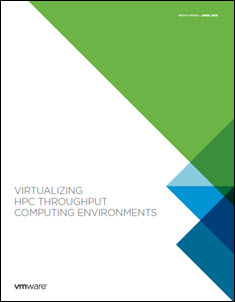Many in the industry are used to HPC workloads being run on bare-metal, unvirtualized hardware. But today’s enterprises are beginning to see the benefit and value of virtualization for HPC environments.

Download the full report.
In fact, according to a new white paper from VMware that explores virtualizing HPC throughput computing environments, performance of these HPC workloads has increased dramatically over the past decade as hardware support for virtualization has moved forward by leaps and bounds.
The report walks readers through the application of virtualization to HPC, while also evaluating the performance of HPC workloads in a virtualized, multitenant computing environment.
For HPC, parallelism is often the key to achieving desired performance, and normally involves many processes running simultaneously.
“Depending on the amount of communication among the parallel processes, HPC workloads can be broadly divided into throughput workloads and parallel distributed workloads,” the white paper states. VMware’s latest study focuses primarily on the virtual performance of these throughput workloads.
Although just a few years ago, HPC workloads were most often run on bare-metal systems, the lay of the land is starting to shift, as enterprises start to realize that virtualization can also often add value in HPC environments.
The white paper outlines some of the potential benefits of virtualization in detail, including:
- Supports a more diverse end-user population with differing software requirements
- Provides data security and compliance by isolating user workloads into separate VMs, including running within different software-defined virtual networks
- Provides fault isolation, root access, and other capabilities not available in traditional HPC environments through the use of VMs
- Creates a more dynamic IT environment in which VMs and their encapsulated workloads can be live-migrated across the cluster for load balancing, for maintenance, for fault avoidance
The VMware white paper also explores different HPC workload and HPC environment examples.
In HPC, performance is of paramount importance, and delivering high performance in the VMware virtual environment has been a key part of the work required to make virtualization viable for these workloads.
According to the report, InfiniBand and RDMA are the two most widely used hardware and software approaches for HPC message passing — and they can be used in a virtual environment, as well.
Check out the full report for results from VMware tests, as well, during which the company compares the runtime of each program in the benchmark suite, running each within a VM and on bare metal, using identical hardware and OSs for each test.
And although it is evident virtualization can bring added value and flexibility to HPC environments, VMware points out there are considerations and precautions to take. The company explains users should be careful to configure the virtual environment to simultaneously achieve both agility and high performance. The report section, “Virtualization Considerations” offers further guidance.
What’s driving the trend toward virtualizing HPC environments? The “increased flexibility and agility” that virtualization offers.
Download the new white paper from VMware, “Virtualizing HPC Throughput Computing Environments,” that explores the concepts of virtual throughput clusters and CPU overcommitment with VMware vSphere to create multitenant and agile virtual HPC computing environments.




